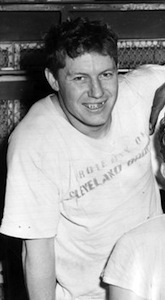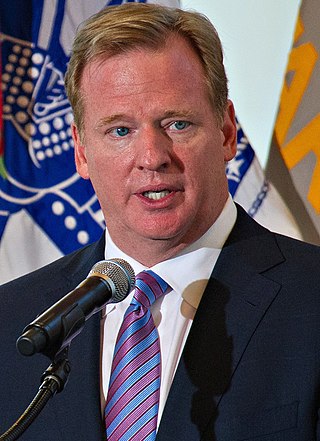Related Research Articles

The All-America Football Conference (AAFC) was a professional American football league that challenged the established National Football League (NFL) from 1946 to 1949. One of the NFL's most formidable challengers, the AAFC attracted many of the nation's best players, and introduced many lasting innovations to the game. However, the AAFC was ultimately unable to sustain itself in competition with the NFL. After it folded, three of its teams were admitted to the NFL: the San Francisco 49ers, the Cleveland Browns and the original Baltimore Colts.

The Professional Football Researchers Association (PFRA) is an organization of researchers whose mission is to preserve and, in some cases, reconstruct professional American football history. It was founded on June 22, 1979 in Canton, Ohio by writer/historian Bob Carroll and six other football researchers and is currently headed by an executive committee led by its president, George Bozeka, and executive director Leon Elder. Membership in the organization includes some of professional football's foremost historians and authors. The organization is based in Guilford, New York.
Throughout its history, the National Football League (NFL) and other rival American football leagues have used several different formats to determine their league champions, including a period of inter-league matchups to determine a true national champion.
John Peter "Pete" Layden, Jr. was an American two-sport professional athlete who played outfielder in Major League Baseball and an assortment of positions in football. He was an outfielder for the St. Louis Browns and a quarterback, running back, cornerback, kick returner, punt returner, and punter for the New York Yankees of the All-America Football Conference (AAFC) and the New York Yanks of the National Football League (NFL).
The American Football League, also known retrospectively as the AFL III to distinguish it from earlier organizations of that name, was a professional American football league that operated from 1940–1941. It was created when three teams, the original Cincinnati Bengals, the Columbus Bullies, and the Milwaukee Chiefs, were lured away from the minor-league American Professional Football Association and joined three new franchises in Boston, Buffalo, and New York City in a new league. It competed against the National Football League (NFL), the oldest existing professional football league, established 1920 and reorganized 1922.
The American Football League (AFL) was a professional American football league that operated in 1936 and 1937. The AFL operated in direct competition with the more established National Football League (NFL) throughout its existence. While the American media generally ignored its operation, this second AFL was the first "home" of the Cleveland Rams, which joined the National Football League after one year in the AFL.
The Midwest Football League (MFL) was a professional american football minor league that existed from 1935 to 1940. Originally comprising teams from Ohio, Kentucky, Indiana, and Illinois, the league eventually expanded its reach to include teams from Missouri, Tennessee, Wisconsin, and California to become a national league with major league aspirations by 1939. In 1938, the league became the American Professional Football League after the collapse of the second major league of the same name, but changed its name once again the following year to American Professional Football Association (APFA). Some sources refer to it as the American Professional Football League.
The Pacific Coast Professional Football League (PCPFL), also known as the Pacific Coast Football League (PCFL) and Pacific Coast League (PCL) was a professional American football minor league based in California. It operated from 1940 through 1948. One of the few minor American professional sports leagues that competed in the years of World War II, the PCPFL was regarded as a minor league of the highest level, particularly from 1940 to 1945, at a time in which the major National Football League did not extend further west than Chicago and Green Bay. It was also the first professional football league to have a team based in Hawaii.
The Northwest War Industries League and American Football League were two closely related professional football minor leagues based on the West Coast of the United States that played for two nonconsecutive seasons during World War II.

The Los Angeles Bulldogs were a professional American football team that competed from 1936 to 1948. Formed with the intention of joining the National Football League in 1937, the Bulldogs were the first team on the major league level to play its home games on the American West Coast. They were considered "the best football team in existence outside the NFL".
The American Association (AA) was a professional American football minor league based in New York City. Founded in 1936 with teams in New York and New Jersey, the AA extended its reach to Providence, Rhode Island prior to the onset of World War II. After a four-year hiatus, the league was renamed the American Football League as it expanded to include teams in Ohio and Pennsylvania. In 1947, the Richmond Rebels of the Dixie League purchased the assets of the defunct AFL Long Island Indians and jumped leagues.

Edgar Francis "Special Delivery" Jones was an American football running back who played for the Chicago Bears of the National Football League (NFL) and the Cleveland Browns of the All-America Football Conference (AAFC). Jones played college football at the University of Pittsburgh where he finished seventh in the Heisman Trophy voting in 1941.
The "Dixie League" was a professional american football minor league founded in 1936 originally as the "South Atlantic Football Association", with six charter member teams in the Middle Atlantic states of Maryland, Virginia, and Washington, D.C. Like the American Association (nicknamed the 'A.A.', which was another minor league in pro football that formed in 1936,, its popularity rivaled that of another earlier established "major league" grouping, the National Football League of 1922. Unlike most professional football minor leagues, the "Dixie League" had a relative stability in membership during the "Great Depression" in the years prior to World War II, maintaining a five or six-team lineup membership of franchises.
The Buffalo Indians were a professional American football team that competed in the third American Football League in 1940 and in 1941. The team played its home games in Civic Stadium in Buffalo, New York. Owned by the Buffalo American Legion, the Indians were managed by Earl "Red" Seick, who was also player-coach for the team for the first five games in 1940. While most of the AFL membership focused on raiding the rosters of the local members of the National Football League teams, the Indians concentrated on signing local talent, castoffs from the NFL, and men who played in the defunct second American Football League.

In the United States and Canada, the term professional football includes the professional forms of American and Canadian gridiron football. In common usage, it refers to former and existing major football leagues in either country. Currently, there are multiple professional football leagues in North America: the two best known are the National Football League (NFL) in the U.S. and the Canadian Football League (CFL) in Canada. American football leagues have existed in Europe since the late 1970s, with competitive leagues all over Europe hiring American Imports to strengthen rosters. The Austrian Football League and German Football League top division are known as the best leagues in Europe. The Japan X-League is also a strong league that has a long history since 1971. The NFL has existed continuously since being so named in 1922.

The National Football League Commissioner is the chief executive officer of the National Football League (NFL). The position was created in 1941. The current commissioner is Roger Goodell, who assumed office on September 1, 2006.
Charles Bernard Fenenbock was an American football player who starred in college at UCLA, and professionally in the Pacific Coast Professional Football League (PCPFL), the National Football League (NFL), the All America Football Conference (AAFC), and the Canadian Football League (CFL). Notably he was a running back for the Detroit Lions in the NFL, and for the Los Angeles Dons in the AAFC where he led the league in numerous offensive categories.
Joseph Rosentover became the manager and president of the American Association football league in 1936 and also became the president of Atlantic Coast Football League in 1963.
Minor league football is an umbrella term for pro football (gridiron) which is played below the major league level.
References
- 1 2 PCPFL: 1940-45 Archived 2011-07-26 at the Wayback Machine – Bob Gill, The Coffin Corner, Pro Football Researchers Association (1982)
- 1 2 3 4 5 6 7 8 9 10 A History of the Dixie League [ permanent dead link ] – Bob Gill, Pro Football Researchers Association (1988)
- ↑ "Football Leagues Will Select 'Czar'". The New York Times. January 18, 1941.
- ↑ "Layden's Job Starts Squawk". The Boston Daily Globe. February 6, 1941.
- ↑ "Storck Quits Post In Surprise Move". The New York Times. April 5, 1941.
- 1 2 3 4 5 6 7 8 9 10 All for One… The Minor Leagues' "Big Three" Make History in 1946 Archived 2010-11-27 at the Wayback Machine – Bob Gill, Pro Football Researchers Association (1989)
- ↑ "3 Top Minor Football Leagues In Alliance to Combat 'Jumping'; Pacific Coast, American and Dixie Circuits to Ask N.F.L. to Join - Plan Protection of Clubs' Territorial Rights" - New York Times, 24 March 1946
- ↑ Tacoma Story Archived 2010-11-26 at the Wayback Machine – Bart Ripp, The Coffin Corner, Pro Football Researchers Association (2002)
- ↑ Nothing Minor About It: The American Association/AFL of 1936-1950 Archived March 26, 2012, at the Wayback Machine – Bob Gill, Pro Football Researchers Association (1990)
- ↑ "Football Pact Ended; Bell Reveals That N.F.L. and American Loop Have Parted" - New York Times, 10 February 1948
- ↑ The End of the PCPFL Archived 2010-11-27 at the Wayback Machine – Bob Gill, The Coffin Corner, Pro Football Researchers Association (1983)
- ↑ Nothing Minor About It: The American Association/AFL of 1936-1950 Archived March 26, 2012, at the Wayback Machine – Bob Gill, Pro Football Researchers Association (1990)